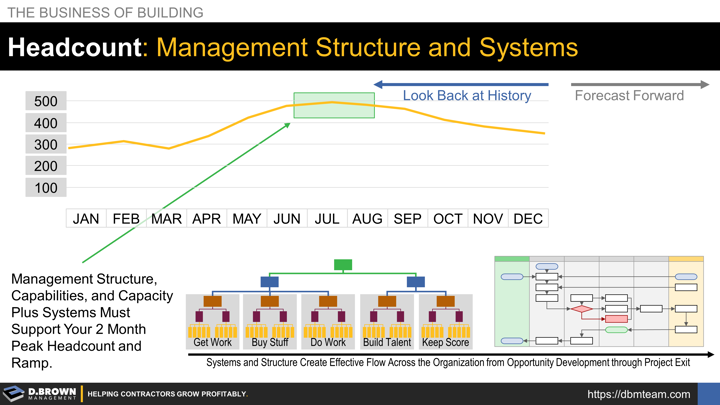Headcount drives many of the changes required in a contractor's management structure, management systems, strategies, and leadership focus. These are the stages of contractor growth.
- Some types of work and geographies are very seasonal, so they have peaks every year.
- Some projects require large peaks in field workforce.
- Sometimes you have a group of projects that are all peaking together causing a compounding effect.
- Sometimes that ramp-up to peak is a 10% fluctuation in the field workforce, other times it is 200%.
If you don't have the right capabilities and capacity in place with your management structure and systems to support both your peak headcount and the rate of the ramp-up, then you are adding incredible levels of risk to your business.
The least of these risks is to your profitability and cash flow - though this will hurt a lot, possibly even catastrophically.
Your far greater risks are with safety, quality, team morale possibly leading to high turnover, and customer satisfaction.
Start by looking back at history over the last few years to see what your average 2-month peak headcount has been during the year, and what your ramp-up rate was.
Define your ramp-up rate as both:
- Percent of workforce growth by month leading up to the peak.
- Total gross hires per month required by month leading up to the peak knowing you will have turnover with new hires.
This applies whether you are a self-perform contractor or a general contractor. For a general contractor or construction manager, there is a huge difference between managing a project with 50 people on-site as compared to 150 or 500.
Look forward at your forecasts over the next 1-3 years and see what your peaks look like going forward.
If you are growing, your peak last year may be your new baseline two years from now, so you need to build your organizational structure and management systems accordingly.
Remember that ramping-down takes as many resources as ramping-up.
Remember that new team members require significantly more management time than those that have been with you and in the same role for 1 year and 3+ years.
Pay heavy attention to what your ratios will look like by job role:
- First 90 Days
- > 90 Days and < 1 Year
- 1-3 Years
- 3+ Years
A manager whose team all has 3+ years in their roles can manage 2-3X the number of people they could if their team all had less than 1 year in their roles.
Also pay heavy attention to the experience of the manager overseeing these people categorizing them similarly.
A manager with a proven track-record who has been with you, and in their role for 3+ years can effectively manage 2-3X the number of people that a less experienced manager can.
The last thing to look at is your systems including your technology. Almost all workflows and technology that worked great at a certain size will breakdown at some point. Watch for excessive errors and frustration. These are often covered up by your team taking "Extreme Ownership" and just working through it. This is exactly the behavior you want and need, but it is not a long-term solution if the systems just continue to worsen with growth.

